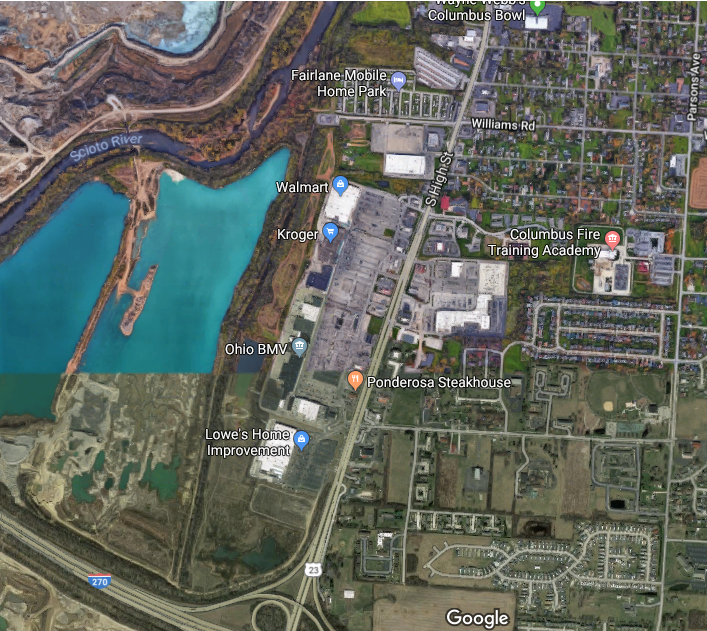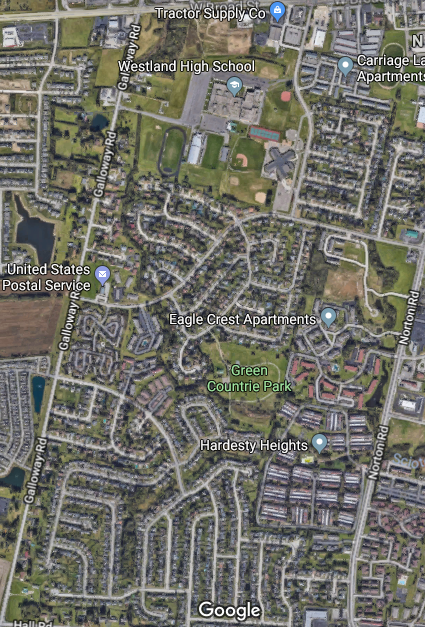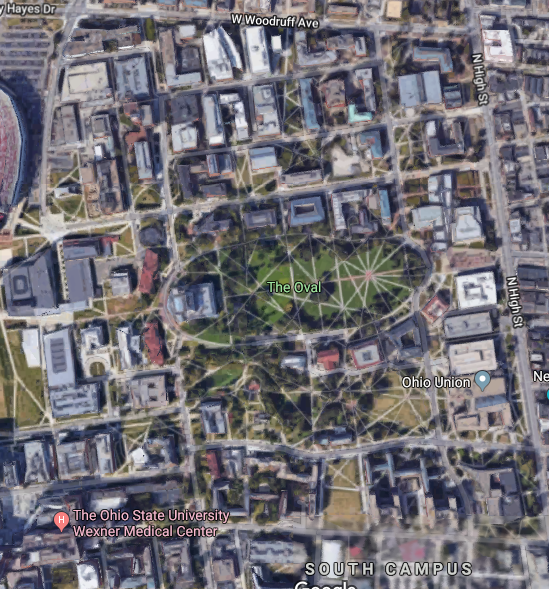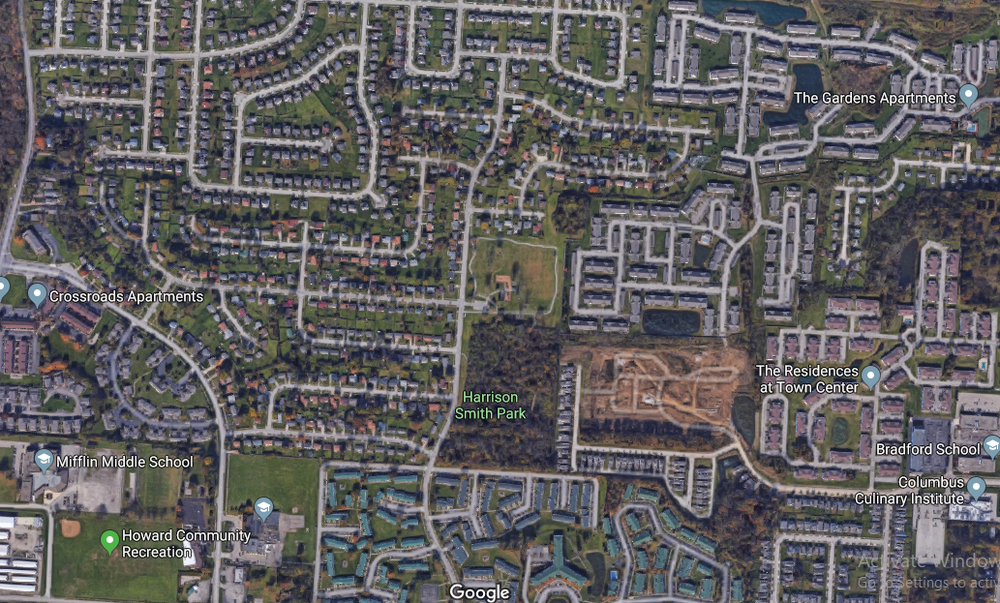Everything posted by jonoh81
-
Ohio Census / Population Trends & Lists
woah woah woah Is there still a Ponderosa Steakhouse in Columbus? Apparently. I went through that south side area a few weeks back and saw it. I was just as surprised as you.
-
Ohio Census / Population Trends & Lists
Are these rhetorical questions? Because this seems to be turning into a potentially treacherous "my city is less/more dense than your city" comparison which falls into city vs. city shouting matches we are trying to avoid. Nope, not rhetorical. I'm honestly curious how the perception of Columbus' neighborhood density compares to real life. The tracts pictured, I thought, were a good representation of most of Columbus' built environment. I find the subject interesting to discuss and just wanted to hear people's thoughts on what those areas seemed to be.
-
Ohio Census / Population Trends & Lists
Yeah, that's all 30x150 or 35x150 lots, which is why it's impossible for Columbus to be effectively denser than Cincinnati. Much of Cincinnati is comprised of 25x100 or smaller lots and many of those lots have multifamilies on them. I have already mentioned this. I own a single-family home on a 25x90 lot that has a 4-unit on one side and a 3-unit on the other. Such a situation is basically non-existent in Columbus because there is almost no such thing as a street platted to 25-foot lots. My cousin owns a 15-foot wide house nearby. There is no such thing as a 15-foot wide row house in Columbus. The 25x100 lots represent *most* of the residential lots situated within a 3- mile radius of Fountain Square, and that includes both sides of the river. Newport, KY is comprised mostly of 25x100 lots: https://www.google.com/maps/place/Newport,+KY+41071/@39.0886344,-84.4963964,1929m/data=!3m1!1e3!4m5!3m4!1s0x8841b10b08002211:0x5dea4a7640e40f0d!8m2!3d39.091449!4d-84.4957757 I'm not sure why you're talking about lot size. The number of people actually living there is directly correlated to density, not strictly the number of houses in a given area. You seem to be talking more about building density than population density. In any case, any guesses as to the density of the areas shown above? How many were below 2,500. How many above 10K, if any?
-
Ohio Census / Population Trends & Lists
Finally we have 8822, on the Far South Side along 23/S. High and just north I-270. It includes a wide mix of single-family homes, large commercial developments, a huge quarry, farm fields and various other things. What is the density?
-
Ohio Census / Population Trends & Lists
This is 8132, on the Far West Side, south of West Broad and west of I-270 near at Westland High School. Immediately west of this is fields and the beginning of the Big Darby protected area. There's a mix of schools, parks, single-family homes and some commercial development. Fairly typical suburbia for Columbus. What is the density?
-
Ohio Census / Population Trends & Lists
This is Tract 55, south of Livingston Avenue on the Near South Side. It is a historically older neighborhood, built mostly between 1880-1920 on a classic grid pattern. What is the density?
-
Ohio Census / Population Trends & Lists
This is Tract 6393. It is on the far northern boundary of Franklin County north if I-270, almost as far from the core as the city limits go. It is almost entirely somewhat newer single-family homes. What is the density?
-
Ohio Census / Population Trends & Lists
This is Tract 1121, which includes a good part of the main OSU campus, specifically the Oval and large apartment buildings to the north and south. What is the density?
-
Ohio Census / Population Trends & Lists
This is Census Tract 330, in northern Linden. The homes here are smaller and older than 7551. What is the density?
-
Ohio Census / Population Trends & Lists
Let's challenge perception versus reality in regards to Columbus density. This first photo is an aerial of most of Census Tract 7551. It is the area south of Easton. Most of it is single-family homes, a few parks and apartments clustered in the southeast. The tract is divided into 2 census block groups. What would you guess the density is?
-
Ohio Census / Population Trends & Lists
I'm not certain I understand the question. The place to start is something like a dot map. That's as close to "raw data" as we can get right now. (And even that assumes that we're all happy with focusing on "nighttime" population, and don't care about any differences in daytime density created by jobs, entertainment, etc.) So how do you want to define boundaries on such a map in order to define a "city" density that is meaningful? I mean, I thought that distance from city hall was brilliant, but then you have the problem of the lake! If you want to show that Columbus is more dense, then I think you can do it. If you want to show that Cincinnati is more dense, then I think you can probably do that too. It's sort of like gerrymandering - if you allow the boundaries to be anything, you can have the result that you want. The suggestion is that the numbers are wrong because places like Cincinnati have hills and other geographic/development areas that cannot have population. However, Cincinnati is only 78 square miles. Columbus is about 219, almost 3x larger. My question is how a much smaller city can have so much more no-density area than a city 3x its size, especially one like Columbus that supposedly also has many more low-density suburban neighborhoods within its borders? That wouldn't make sense. Essentially, the majority of Cincinnati would have to be devoid of people for this to work as claimed. We're talking density here. Cincinnati wouldn't have to have more non-developable area than Columbus; it would need a greater fraction of it's total land area that was non-developable. That's completely believable. I mean, you're not going to ever compare density for a land area larger than Cincinnati's of 78 sq. mi., right? So how much non-developable land is there in Cincinnati, versus any reasonable 78 sq. mi you pick in Columbus? But I guess you're rejecting my main point, which was that the scale of analysis (and the boundaries for it) matter. They might even dominate. That's why I personally get more out of things like dot maps, cause I can (sort of) let my eye estimate the different ways of calculating density, and I can see the non-dense versus denser areas, which is interesting and practical. But again, you can't just point to areas that don't have any development, because density is based on population divided by area size. Low-density areas mean low population. So does Cincinnati not only have a greater area of no development, but low-density development than Columbus? I'm just trying to understand what I've seen people say over the years- that Columbus is low-density sprawl and doesn't seem dense at all. So either that is true or its fraction of it is lower. That's my point. It has to be either higher density overall or have a lower fraction of no and low population areas. Area size matters because its population has to be divided into a much larger area. If Columbus was 78 square miles, its density would be the highest of the 3-Cs, by several thousand, and we wouldn't be having the debate at all. Dot maps can show where the population lives and doesn't live, but not tell exactly how dense the population is overall.
-
Ohio Census / Population Trends & Lists
I'm not certain I understand the question. The place to start is something like a dot map. That's as close to "raw data" as we can get right now. (And even that assumes that we're all happy with focusing on "nighttime" population, and don't care about any differences in daytime density created by jobs, entertainment, etc.) So how do you want to define boundaries on such a map in order to define a "city" density that is meaningful? I mean, I thought that distance from city hall was brilliant, but then you have the problem of the lake! If you want to show that Columbus is more dense, then I think you can do it. If you want to show that Cincinnati is more dense, then I think you can probably do that too. It's sort of like gerrymandering - if you allow the boundaries to be anything, you can have the result that you want. The suggestion is that the numbers are wrong because places like Cincinnati have hills and other geographic/development areas that cannot have population. However, Cincinnati is only 78 square miles. Columbus is about 219, almost 3x larger. My question is how a much smaller city can have so much more no-density area than a city 3x its size, especially one like Columbus that supposedly also has many more low-density suburban neighborhoods within its borders? That wouldn't make sense. Essentially, the majority of Cincinnati would have to be devoid of people for this to work as claimed.
-
Ohio Census / Population Trends & Lists
Almost all major cities saw core population decline in the years. What’s interesting now is that the city is adding almost no land but has growth exceeding the peak annexation years. Beyond that, most of that growth is happening in the most urban neighborhoods rather than the fringe. This may have something to do with single family home construction being so low right now.
-
Ohio Census / Population Trends & Lists
So a question... Columbus is roughly 150 square miles larger than Cincinnati or Cleveland. How is it possible that there is so much of those cities that is empty that it compensates for Columbus having 3x the area size?
-
Ohio Census / Population Trends & Lists
There is simply no question that the areas within the City of Cincinnati that are residential are generally more densely built than are the prewar sections of Columbus. Cincinnati has many, many more homes and multifamilies built on 20x90 lots whereas the smallest Columbus gets is about 30x150 and most lots are more like 35 or 40 feet wide. That makes a huge difference extrapolated over a large area. Good example of how Cincinnati has dense residential nodes surrounded by large areas with almost zero residents: A lot of Columbus is more like this: There is a question if we're still just basing this off of perceptions rather than measured areas. Again, the only way I can think of to get a good picture is to do each city block by block, eliminating the non-population areas. Until someone does this, claims that one city is clearly worse than the other is just unsupported speculation.
-
Ohio Census / Population Trends & Lists
This has come up a few times before - Cincy and Cleveland feel more dense because the neighborhoods themselves likely are, but each city has more land taken up by things like undeveloped hillsides, flood plains, and industry than Columbus does, so the overall average density is much lower. Looking at a map of Cincinnati's city limits - nearly 1/3 of the land is either undeveloped hillsides or in the Ohio/Little Miami flood plain. The Mill Creek Valley is entirely industrial from St. Bernard to the Ohio River. The rail yards alone in Queensgate/Camp Washington are larger than all of Over-the-Rhine. That's a ton of acreage with 0 people per square mile. The numbers don't include water. All cities have undevelopable land, industry, etc. I'm pretty sure the difference in growth rates account for far more than what you're talking about. Plus, isn't the criticism of Columbus that so much of its development is low-density sprawl or that it has a lot of empty land within its limits? I feel like people are trying to have it both ways here. Also, if you removed all that land in the other 2, you'd also have to remove it for Columbus, meaning that all 3 would see their densities rise. You would have to somehow show that the differences in land use would create a different picture. I guess if someone wanted to really do it, they could go all the way down to the block level, but that would take a good amount of work to do. Otherwise, it's just an assumption, not a fact.
-
Ohio Census / Population Trends & Lists
Columbus was 879,170 / 218.5sq.mi. All the numbers are based on land only, no water. But yeah, Columbus has more density than people think.
-
Ohio Census / Population Trends & Lists
Current Population Densities- land only Metro Area Cleveland: 1,031.3 Cincinnati: 496.3 Columbus: 433.4 Metro Area Density Change 2010-2017 Columbus: +36.8 Cincinnati: +14.7 Cleveland: -9.2 County Cuyahoga: 2,732.0 Franklin: 2,428.5 Hamilton: 2,004.5 Summit: 1,313.9 Lucas: 1,263.6 Montgomery: 1,150.5 County Density Change 2010-2017 Franklin: +289.9 Hamilton: +28.2 Summit: -0.8 Montgomery: -7.8 Lucas: -32.0 Cuyahoga: -69.1 City Cleveland: 4,961.7 Columbus: 4,023.7 Cincinnati: 3,865.8 Toledo: 3,432.2 Akron: 3,189.5 Dayton: 2,522.4 City Density Change 2010-2017 Columbus: +400.2 Cincinnati: +55.9 Akron: -17.8 Dayton: -35.2 Toledo: -124.5 Cleveland: -143.8
-
Ohio Census / Population Trends & Lists
Just for the 3-Cs... % of Cumulative Metro Population Change Occurring in the Core County 2010-2017 Franklin: 72.75% Hamilton: 17.78% Cuyahoga: -100.00% Ranking in the top 50 largest metros: 9th, 42nd, 50th, respectively. And % of Cumulative Metro Population Change Occurring in the Core City 2010-2017 Columbus: 52.14% Cincinnati: 6.76% Cleveland: -59.09% Ranking in the top 50 largest metros: 5th, 40th, 49th. Columbus was one of only 5 cities in the top 50 largest metros to have more than 50% of the metro growth occur in the core city. The others were New York, New Orleans, San Antonio and San Jose. County Population Change Per Square Mile 2010-2017 Franklin: +241.67 Hamilton: +28.20 Cuyahoga: -69.16 Ranking in the top 50 largest metros: 12th, 37th, 47th. City Population Change Per Square Mile 2010-2017 Columbus: +424.26 Cincinnati: +55.89 Cleveland: -140.14 Ranking in the top 50 largest metros: 18th, 38th, 47th.
-
Columbus: Downtown: The Reach on Goodale / White Castle HQ
It is how they deal with the parking that is my main complaint. The buildings are ok I guess, and even the layout. The way they deal with and place the parking is problematic for me. One six story garage for the parking would allow for space for another building or more greenspace. No reason for a two story garage and a surface parking lot here. But it is by far not the most important part of downtown so meh basically. Development pressure/demand may entice them to do that at some point... at least that's a possibility. Surface lots are antiquated in an urban setting, but the good thing is that they are easily buildable.
-
Ohio Census / Population Trends & Lists
Tourism maybe, but I think Ohio and its cities in general receives far more tourism than people think. Ohio in tourism dollars beats almost all the South except I think Florida and Texas. And all that tourism hasn't translated to growth. Nashville is incorporated into its county the way Indianapolis is, so its city limits are much larger than Columbus or any Ohio city. Yet it had less than 3,000 people move there last year. For all the supposed building, tourism and national reputation, it's consistently had weak population growth, especially for such a large area. Tourism apparently doesn't translate to quality of life issues that are attractive to real movers. Nashville is clearly being overrated by many. And I agree with you that Nashville is overrated but my point was more to do with perception than reality. Tourism is different there than in Ohio. In Nashville, you will have music stars and other celebs more likely to grab a high rise condo that sits empty 360 days of the year. You don't get that in Columbus. Because of its international appeal, you may get a Saudi Sheik looking for a place to dump capital that is not New York, LA or Miami and may snag a condo there for a while that sits empty. Ultimately, you have a bunch of high end real estate there that is built but empty 99% of the time. You do not have that market in Columbus. I am not saying it is in Nashville much either, but Nashville has greater potential for that then Columbus. Maybe, but I'm not sure any of that is actually good for Nashville. Having a bunch of empty buildings that no one is actually moving to doesn't really add much more than a nice skyline. What's interesting to me about Columbus is that, nationally, it has very little reputation, positive or negative. Yes, there have been some positive media stories at times, but it consistently flies under the radar more often than not. Hype feeds hype, and you get cities like Austin and Nashville attracting people to their metros often just because they've become popular in the media. Yet Columbus really has none of that. The media attention it gets, if at all, is along the lines of, "Wow, I can't believe there's a decent city in flyover country!" It's annoying, but that's the reality. So to me, its rise to become a top 10 fastest-growing city is really kind of remarkable. It's going to be interesting watching the city evolve from here, and whether the boom is temporary or something that is going to stick around for a while.
-
Cleveland: Population Trends
Yes, they come out in December normally. Those for up to 2016 are already out on the FactFinder page.
-
Ohio Census / Population Trends & Lists
Maybe in the rest of the state, but out of the 102 cities, towns and villages in the 10-county Columbus metro, 83 of them posted growth 2016-2017, with another 8 maintaining population. I think that's pretty remarkable for Ohio. If you're from close to Columbus you don't have to leave. You may want to leave to live in a city with rail transit. Even if your small town has no jobs itself you can drive 15 minutes to Groveport, Obetz, Reynoldsburg or West Jeff for a warehouse job. What's interesting is that there's some evidence that when Perry and Hocking counties were added to the Columbus metro, populations in their towns and villages stabilized and have even increased. Yet proximity didn't change. You're right that proximity to a good job market helps, but I really think that there may be some positive feedback in general about being part of the region.
-
Ohio Census / Population Trends & Lists
Tourism maybe, but I think Ohio and its cities in general receives far more tourism than people think. Ohio in tourism dollars beats almost all the South except I think Florida and Texas. And all that tourism hasn't translated to growth. Nashville is incorporated into its county the way Indianapolis is, so its city limits are much larger than Columbus or any Ohio city. Yet it had less than 3,000 people move there last year. For all the supposed building, tourism and national reputation, it's consistently had weak population growth, especially for such a large area. Tourism apparently doesn't translate to quality of life issues that are attractive to real movers. Nashville is clearly being overrated by many.
-
Columbus: Victorian Village Developments and News
jonoh81 replied to Summit Street's post in a topic in Central & Southeast Ohio Projects & ConstructionThe census estimates coming out make larger projects like this even more of a "threat" and necessity. Columbus' population growth is only accelerating, and housing construction has largely failed to recover from the recession of 2008-2010. Inventory is low, prices are rising and demand is at record levels. There's increasing pressure, not to mention money to be made, on going larger in hot neighborhoods. We've been seeing this even in places like Upper Arlington with the proposed 11-story there. This project is going to be built, and given the statements by Kaufman, it's going to be built as large as they can reasonably do. They see the market and are responding to it.










